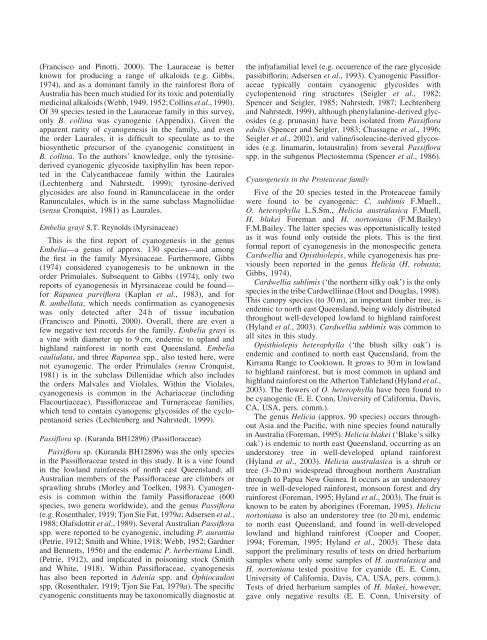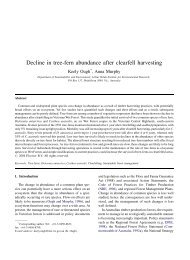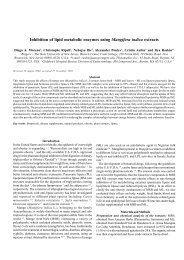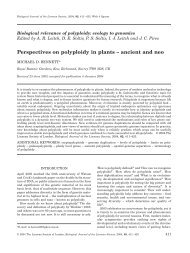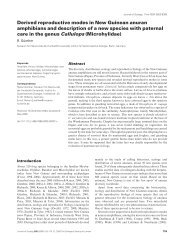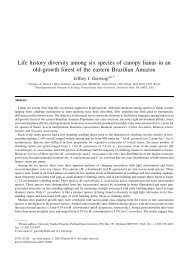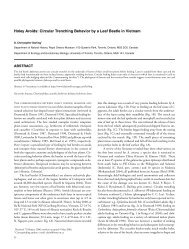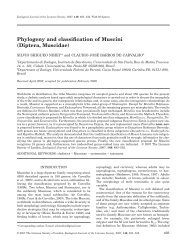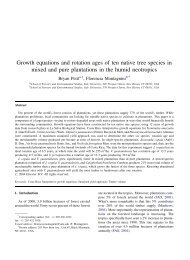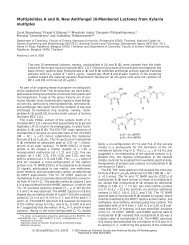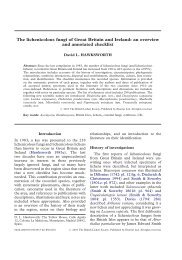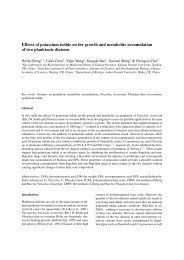Frequency of Cyanogenesis in Tropical Rainforests of Far North ...
Frequency of Cyanogenesis in Tropical Rainforests of Far North ...
Frequency of Cyanogenesis in Tropical Rainforests of Far North ...
You also want an ePaper? Increase the reach of your titles
YUMPU automatically turns print PDFs into web optimized ePapers that Google loves.
(Francisco and P<strong>in</strong>otti, 2000). The Lauraceae is better<br />
known for produc<strong>in</strong>g a range <strong>of</strong> alkaloids (e.g. Gibbs,<br />
1974), and as a dom<strong>in</strong>ant family <strong>in</strong> the ra<strong>in</strong>forest flora <strong>of</strong><br />
Australia has been much studied for its toxic and potentially<br />
medic<strong>in</strong>al alkaloids (Webb, 1949, 1952; Coll<strong>in</strong>s et al., 1990).<br />
Of 39 species tested <strong>in</strong> the Lauraceae family <strong>in</strong> this survey,<br />
only B. coll<strong>in</strong>a was cyanogenic (Appendix). Given the<br />
apparent rarity <strong>of</strong> cyanogenesis <strong>in</strong> the family, and even<br />
the order Laurales, it is difficult to speculate as to the<br />
biosynthetic precursor <strong>of</strong> the cyanogenic constituent <strong>in</strong><br />
B. coll<strong>in</strong>a. To the authors’ knowledge, only the tyros<strong>in</strong>ederived<br />
cyanogenic glycoside taxiphyll<strong>in</strong> has been reported<br />
<strong>in</strong> the Calycanthaceae family with<strong>in</strong> the Laurales<br />
(Lechtenberg and Nahrstedt, 1999); tyros<strong>in</strong>e-derived<br />
glycosides are also found <strong>in</strong> Ranunculaceae <strong>in</strong> the order<br />
Ranunculales, which is <strong>in</strong> the same subclass Magnoliidae<br />
(sensu Cronquist, 1981) as Laurales.<br />
Embelia grayi S.T. Reynolds (Myrs<strong>in</strong>aceae)<br />
This is the first report <strong>of</strong> cyanogenesis <strong>in</strong> the genus<br />
Embelia—a genus <strong>of</strong> approx. 130 species—and among<br />
the first <strong>in</strong> the family Myrs<strong>in</strong>aceae. Furthermore, Gibbs<br />
(1974) considered cyanogenesis to be unknown <strong>in</strong> the<br />
order Primulales. Subsequent to Gibbs (1974), only two<br />
reports <strong>of</strong> cyanogenesis <strong>in</strong> Myrs<strong>in</strong>aceae could be found—<br />
for Rapanea parviflora (Kaplan et al., 1983), and for<br />
R. umbellata, which needs confirmation as cyanogenesis<br />
was only detected after 24 h <strong>of</strong> tissue <strong>in</strong>cubation<br />
(Francisco and P<strong>in</strong>otti, 2000). Overall, there are even a<br />
few negative test records for the family. Embelia grayi is<br />
a v<strong>in</strong>e with diameter up to 9 cm, endemic to upland and<br />
highland ra<strong>in</strong>forest <strong>in</strong> north east Queensland. Embelia<br />
caulialata, and three Rapanea spp., also tested here, were<br />
not cyanogenic. The order Primulales (sensu Cronquist,<br />
1981) is <strong>in</strong> the subclass Dilleniidae which also <strong>in</strong>cludes<br />
the orders Malvales and Violales. With<strong>in</strong> the Violales,<br />
cyanogenesis is common <strong>in</strong> the Achariaceae (<strong>in</strong>clud<strong>in</strong>g<br />
Flacourtiaceae), Passifloraceae and Turneraceae families,<br />
which tend to conta<strong>in</strong> cyanogenic glycosides <strong>of</strong> the cyclopentanoid<br />
series (Lechtenberg and Nahrstedt, 1999).<br />
Passiflora sp. (Kuranda BH12896) (Passifloraceae)<br />
Passiflora sp. (Kuranda BH12896) was the only species<br />
<strong>in</strong> the Passifloraceae tested <strong>in</strong> this study. It is a v<strong>in</strong>e found<br />
<strong>in</strong> the lowland ra<strong>in</strong>forests <strong>of</strong> north east Queensland; all<br />
Australian members <strong>of</strong> the Passifloraceae are climbers or<br />
sprawl<strong>in</strong>g shrubs (Morley and Toelken, 1983). <strong>Cyanogenesis</strong><br />
is common with<strong>in</strong> the family Passifloraceae (600<br />
species, two genera worldwide), and the genus Passiflora<br />
(e.g. Rosenthaler, 1919; Tjon Sie Fat, 1979a; Adsersen et al.,<br />
1988; Olafsdottir et al., 1989). Several Australian Passiflora<br />
spp. were reported to be cyanogenic, <strong>in</strong>clud<strong>in</strong>g P. aurantia<br />
(Petrie, 1912; Smith and White, 1918; Webb, 1952; Gardner<br />
and Bennetts, 1956) and the endemic P. herbertiana L<strong>in</strong>dl.<br />
(Petrie, 1912), and implicated <strong>in</strong> poison<strong>in</strong>g stock (Smith<br />
and White, 1918). With<strong>in</strong> Passifloraceae, cyanogenesis<br />
has also been reported <strong>in</strong> Adenia spp. and Ophiocaulon<br />
spp. (Rosenthaler, 1919; Tjon Sie Fat, 1979a). The specific<br />
cyanogenic constituents may be taxonomically diagnostic at<br />
the <strong>in</strong>frafamilial level (e.g. occurrence <strong>of</strong> the rare glycoside<br />
passibiflor<strong>in</strong>; Adsersen et al., 1993). Cyanogenic Passifloraceae<br />
typically conta<strong>in</strong> cyanogenic glycosides with<br />
cyclopentenoid r<strong>in</strong>g structures (Seigler et al., 1982;<br />
Spencer and Seigler, 1985; Nahrstedt, 1987; Lechtenberg<br />
and Nahrstedt, 1999), although phenylalan<strong>in</strong>e-derived glycosides<br />
(e.g. prunas<strong>in</strong>) have been isolated from Passiflora<br />
edulis (Spencer and Seigler, 1983; Chassagne et al., 1996;<br />
Seigler et al., 2002), and val<strong>in</strong>e/isoleuc<strong>in</strong>e-derived glycosides<br />
(e.g. l<strong>in</strong>amar<strong>in</strong>, lotaustral<strong>in</strong>) from several Passiflora<br />
spp. <strong>in</strong> the subgenus Plectostemma (Spencer et al., 1986).<br />
<strong>Cyanogenesis</strong> <strong>in</strong> the Proteaceae family<br />
Five <strong>of</strong> the 20 species tested <strong>in</strong> the Proteaceae family<br />
were found to be cyanogenic: C. sublimis F.Muell.,<br />
O. heterophylla L.S.Sm., Helicia australasica F.Muell,<br />
H. blakei Foreman and H. nortoniana (F.M.Bailey)<br />
F.M.Bailey. The latter species was opportunistically tested<br />
as it was found only outside the plots. This is the first<br />
formal report <strong>of</strong> cyanogenesis <strong>in</strong> the monospecific genera<br />
Cardwellia and Opisthiolepis, while cyanogenesis has previously<br />
been reported <strong>in</strong> the genus Helicia (H. robusta;<br />
Gibbs, 1974).<br />
Cardwellia sublimis (‘the northern silky oak’) is the only<br />
species <strong>in</strong> the tribe Cardwelli<strong>in</strong>ae (Hoot and Douglas, 1998).<br />
This canopy species (to 30 m), an important timber tree, is<br />
endemic to north east Queensland, be<strong>in</strong>g widely distributed<br />
throughout well-developed lowland to highland ra<strong>in</strong>forest<br />
(Hyland et al., 2003). Cardwellia sublimis was common to<br />
all sites <strong>in</strong> this study.<br />
Opisthiolepis heterophylla (‘the blush silky oak’) is<br />
endemic and conf<strong>in</strong>ed to north east Queensland, from the<br />
Kirrama Range to Cooktown. It grows to 30 m <strong>in</strong> lowland<br />
to highland ra<strong>in</strong>forest, but is most common <strong>in</strong> upland and<br />
highland ra<strong>in</strong>forest on the Atherton Tableland (Hyland et al.,<br />
2003). The flowers <strong>of</strong> O. heterophylla have been found to<br />
be cyanogenic (E. E. Conn, University <strong>of</strong> California, Davis,<br />
CA, USA, pers. comm.).<br />
The genus Helicia (approx. 90 species) occurs throughout<br />
Asia and the Pacific, with n<strong>in</strong>e species found naturally<br />
<strong>in</strong> Australia (Foreman, 1995). Helicia blakei (‘Blake’s silky<br />
oak’) is endemic to north east Queensland, occurr<strong>in</strong>g as an<br />
understorey tree <strong>in</strong> well-developed upland ra<strong>in</strong>forest<br />
(Hyland et al., 2003). Helicia australasica is a shrub or<br />
tree (3–20 m) widespread throughout northern Australian<br />
through to Papua New Gu<strong>in</strong>ea. It occurs as an understorey<br />
tree <strong>in</strong> well-developed ra<strong>in</strong>forest, monsoon forest and dry<br />
ra<strong>in</strong>forest (Foreman, 1995; Hyland et al., 2003). The fruit is<br />
known to be eaten by aborig<strong>in</strong>es (Foreman, 1995). Helicia<br />
nortoniana is also an understorey tree (to 20 m), endemic<br />
to north east Queensland, and found <strong>in</strong> well-developed<br />
lowland and highland ra<strong>in</strong>forest (Cooper and Cooper,<br />
1994; Foreman, 1995; Hyland et al., 2003). These data<br />
support the prelim<strong>in</strong>ary results <strong>of</strong> tests on dried herbarium<br />
samples where only some samples <strong>of</strong> H. australasica and<br />
H. nortoniana tested positive for cyanide (E. E. Conn,<br />
University <strong>of</strong> California, Davis, CA, USA, pers. comm.).<br />
Tests <strong>of</strong> dried herbarium samples <strong>of</strong> H. blakei, however,<br />
gave only negative results (E. E. Conn, University <strong>of</strong>


